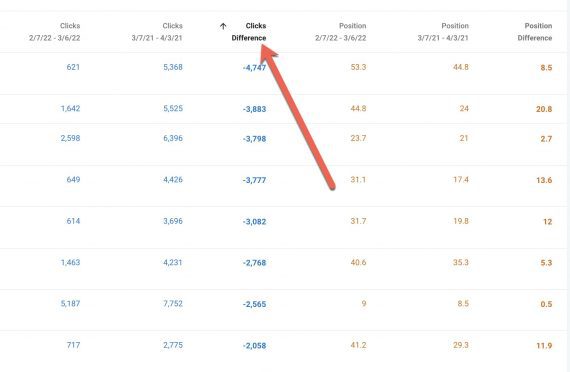Identifying a decline in organic traffic is easy in Google Analytics. What’s not easy is diagnosing the reason — which queries are delivering lesser traffic and why.
Search Console is the only ranking and reporting platform directly from Google. It’s the best way to diagnose a loss in organic traffic.
I’ll explain in this post.
Search Console Steps
1. Identify when you started losing traffic. Select a broad date range in Search Console’s “Performance” section to help determine when the traffic drop began. Go back as far as necessary, although Search Console retains only 16 months of data.

Select a date range in Search Console’s Performance section to determine when the traffic drop began.
2. Compare your organic traffic. Go to Performance > Search Results > Date and click “Compare.” Then choose “Custom” to select the date range that precedes your organic traffic decline.
Keep “Total clicks” and “Average position” active and hide all other metrics, such as “Total impressions” and “Average CTR.” While those latter metrics are useful, we’re focusing on traffic and ranking loss.
3. Identify pages with the biggest losses. Search Console shows traffic losses for specific search queries. But start with a page-by-page view to make the report less cluttered.
Click the “Pages” tab and sort twice by “Clicks Difference” to see the largest loss on top.
Don’t pay much attention to the position difference just yet. The report is aggregate data skewed by queries that were not bringing in much traffic.
Click “Export” at the top right to download the report in Excel, Google Sheets, or .csv. This is your list of pages with the biggest loss of organic clicks. The list does not include the Clicks Difference column (easily recovered via an Excel formula) or your sorting preferences.
An alternative to downloading is to copy-paste your current Search Console view into a spreadsheet.
4. Diagnose each falling page. Using the above report, click each page and identify the primary search query that accounted for the loss.
Sort the chart by “Queries” then by “Clicks Difference.”
Identify drops in search queries, such as:
- Queries containing an old date, such as “2021 running shoes.”
- Queries containing concepts that are no longer popular, such as “2020 presidential election.”
- Queries containing entities (e.g., product and company names) that no longer exist.
Next, activate “Total impressions” from step 2 above. If fewer people are searching on the query, it’s likely not worth prioritizing, even if you lost a position or two.
According to Google, “An impression is counted whenever an item appears in the current page, whether or not the item is scrolled into view.”
So if you see a significant decline in impressions while your page maintains the same ranking (e.g., in top 10 results), it may mean a loss in interest for the query.

Activate “Total impressions.” If fewer people are searching on the query, it’s likely not worth prioritizing.
Additionally, a loss of clicks without a rankings drop may indicate a new search-result feature from Google (such as “People also ask” and video carousels) that lowered your organic result on the page. Unfortunately, there’s little to do to revive those clicks.
5. Identify a possible reason for the loss.
- Outdated content. If you experience a loss in rankings and clicks, consider updating the page with current info and removing broken links and outdated facts.
- Fewer internal links. Consider, also, the internal links to a declining page. Posts on blogs and digital magazines slowly fade from prominence to eventually reside only in archives, many clicks away from the home page. This results in less link equity flowing to those posts and often accounts for the loss of rankings.
The solution is to surface older content. An example is a “Related Posts” plugin with links from new articles to older ones. Promoting your authors’ top content is another good idea.
- Stronger competitors. If the loss in traffic is not due to outdated content or old internal links, study your competitors’ organic-search tactics. Monitoring services such as SE Ranking provide a snapshot of search engine result pages for any monitored query in select third-party tools.
Otherwise, SpyFu retains most popular queries and provides visualizations of search-result movements to see which sites are rising while yours is dropping.
Recoverable?
Not all organic traffic declines are recoverable. Search engine algorithms are ever-changing, prioritizing one signal over the others. However, knowing which pages and queries account for the loss will help diagnose it to assign potential remedies.







